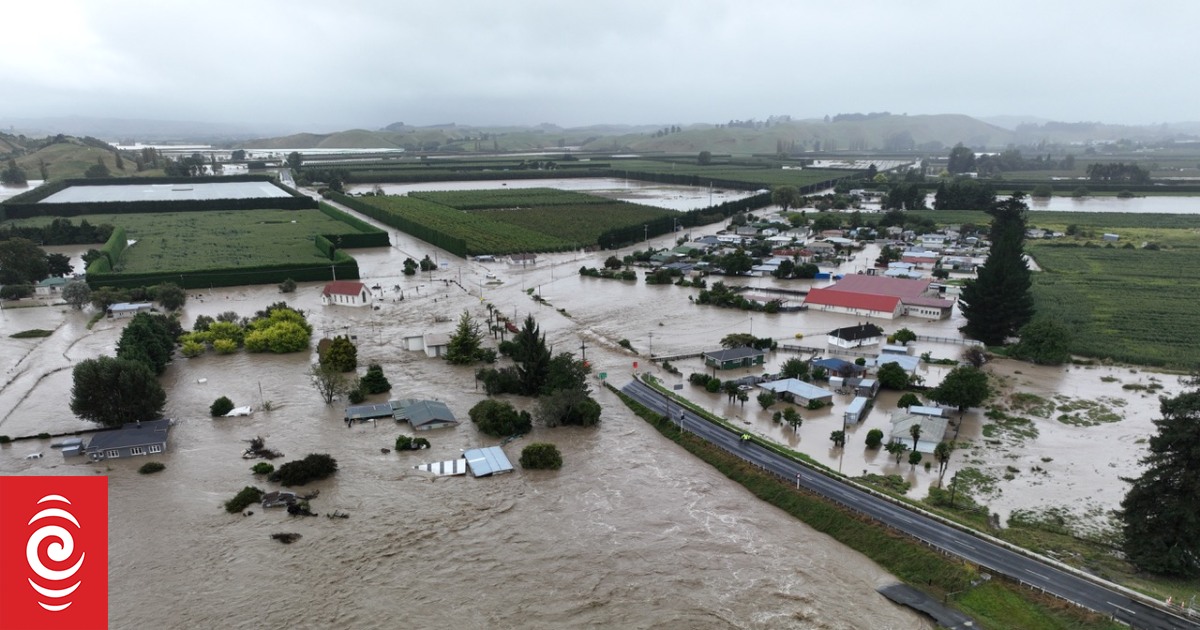Police hold fears for some people who cannot be contacted in either Hawke’s Bay of Tairawhiti.
Photo: Supplied / Dawson Bliss
A child’s body has been found in in Eskdale, Hawke’s Bay and it is believed they were caught in rising floodwaters yesterday.
Police said the discovery lifted the toll following Cyclone Gabrielle to four.
The body of a missing volunteer firefighter was recovered from a landslide in Muriwai in Auckland this afternoon.
A person died following a landslip on a rural property in Matahorua Road, Putorino on Tuesday afternoon.
A body was located on the shore in Bay View, Napier on Tuesday night.
In a statement, police said they wanted to extend their condolences to the families of those who have died and were continuing to make enquiries into the circumstances.
Police said while they had received many reports of people who could not be contacted they held “grave concerns” for some people in Hawke’s Bay and Tairawhiti.
As of 2.30pm today, 1442 people have been registered via the police 105 online reporting form as uncontactable.
There were 111 reports of people now safe.
The vast majority of reports were from Hawke’s Bay and Tairawhiti, with the remainder from other parts of the North Island.
The numbers included duplicate reports of the same person reported uncontactable by different people.
While they expected a large number of the reports to be the result of communication lines being down, police confirmed there were several people missing in the Hawke’s Bay and Tairawhiti areas, for whom they held grave concerns.
Police are focusing their weather response on the Eastern District (Hawke’s Bay and Tairawhiti).
More than 70 staff from Bay of Plenty, Central, Wellington, Tasman, Canterbury and Southern districts, as well as the Royal New Zealand Police College, were being sent to Hawke’s Bay and Tairawhiti over the next 48 hours.
Those staff will support recovery efforts and provide community reassurance.
Police yesterday deployed 12 Search and Rescue specialist staff to assist with recovery efforts in Eastern District, and these efforts were continuing today.
“We are aware that many of our staff in the Hawke’s Bay and Gisborne areas have themselves been affected by the storm, but they have continued to work hard to support rescue efforts, manage road closures, and make contact with isolated people,” the statement said.
Communications into and out of the area continue to be challenging, however, as telecommunication services start to come back online, they expected the number of reports of missing people, found people, damage to property, and demand for basic resources such as food, water, and fuel would all rise.
“In Tāmaki Makaurau and Northland, the focus continues to be supporting the ongoing recovery.
“Police are continuing to carry out reassurance patrolling throughout the regions and in affected areas.”
Police asked anyone concerned about friends and family to try their usual methods of communication first, whether that’s a phone number, email, social media or a pre-planned emergency meeting place.
When all means of contact have been exhausted, anyone with genuine concerns for a person’s safety is asked to provide as much information as possible via the 105 online form.
We continue to urge those who can to call 111 if they are in immediate danger.
National state of emergency: What you need to know
- The New Zealand government has declared a National State of Emergency, to assist in the response to Cyclone Gabrielle.
- The declaration will apply to the six regions that have already declared a local State of Emergency: Northland, Auckland, Tairāwhiti, Bay of Plenty, Waikato, and Hawke’s Bay.
- A national state of emergency gives the national controller legal authority to apply further resources across the country and set priorities in support of a national level response.
National Emergency Management Agency advice:
- Put safety first. Don’t take any chances. Act quickly if you see rising water. Floods and flash floods can happen quickly. If you see rising water do not wait for official warnings. Head for higher ground and stay away from floodwater.
- Stay at home if it is safe to do so. But have an evacuation plan in case your home becomes unsafe to stay in.
- If you have evacuated, please stay where you are until you are given the all-clear to go home.
- People should stay up to date with the forecasts from MetService and continue to follow the advice of Civil Defence and emergency services.
- Do not try to walk, play, swim, or drive in floodwater: even water just 15 centimetres deep can sweep you off your feet, and half a metre of water will carry away most vehicles. Flood water is often contaminated and can make you sick.




















Discussion about this post